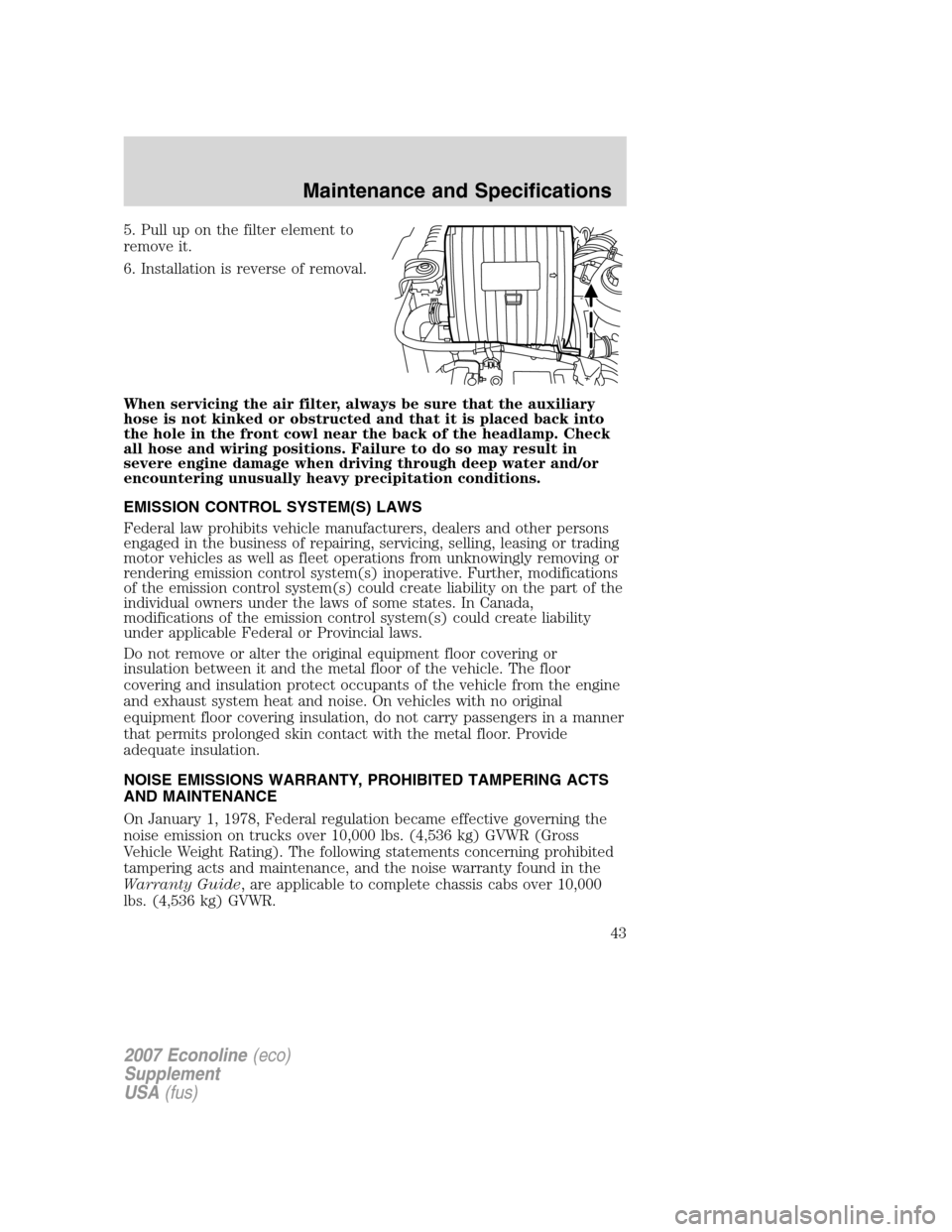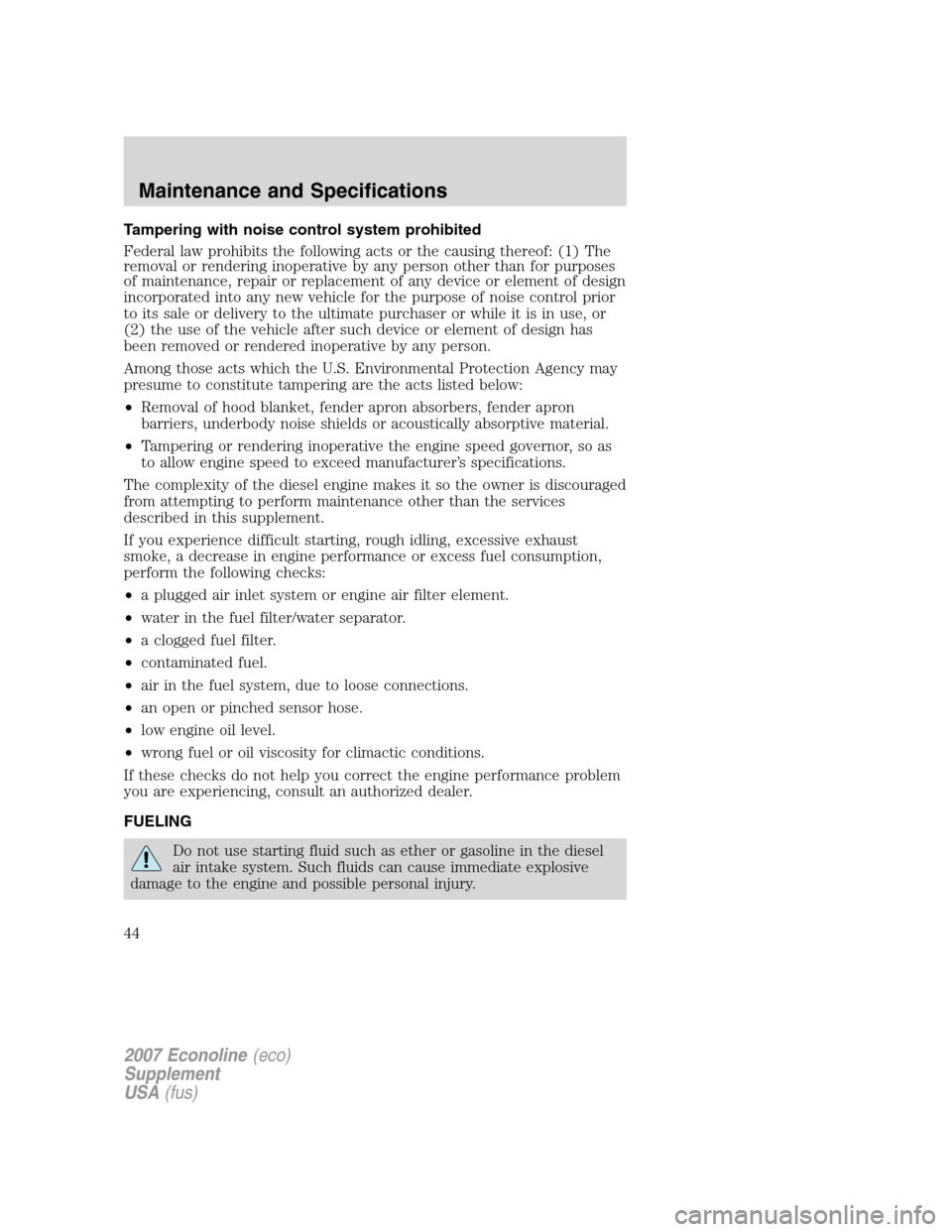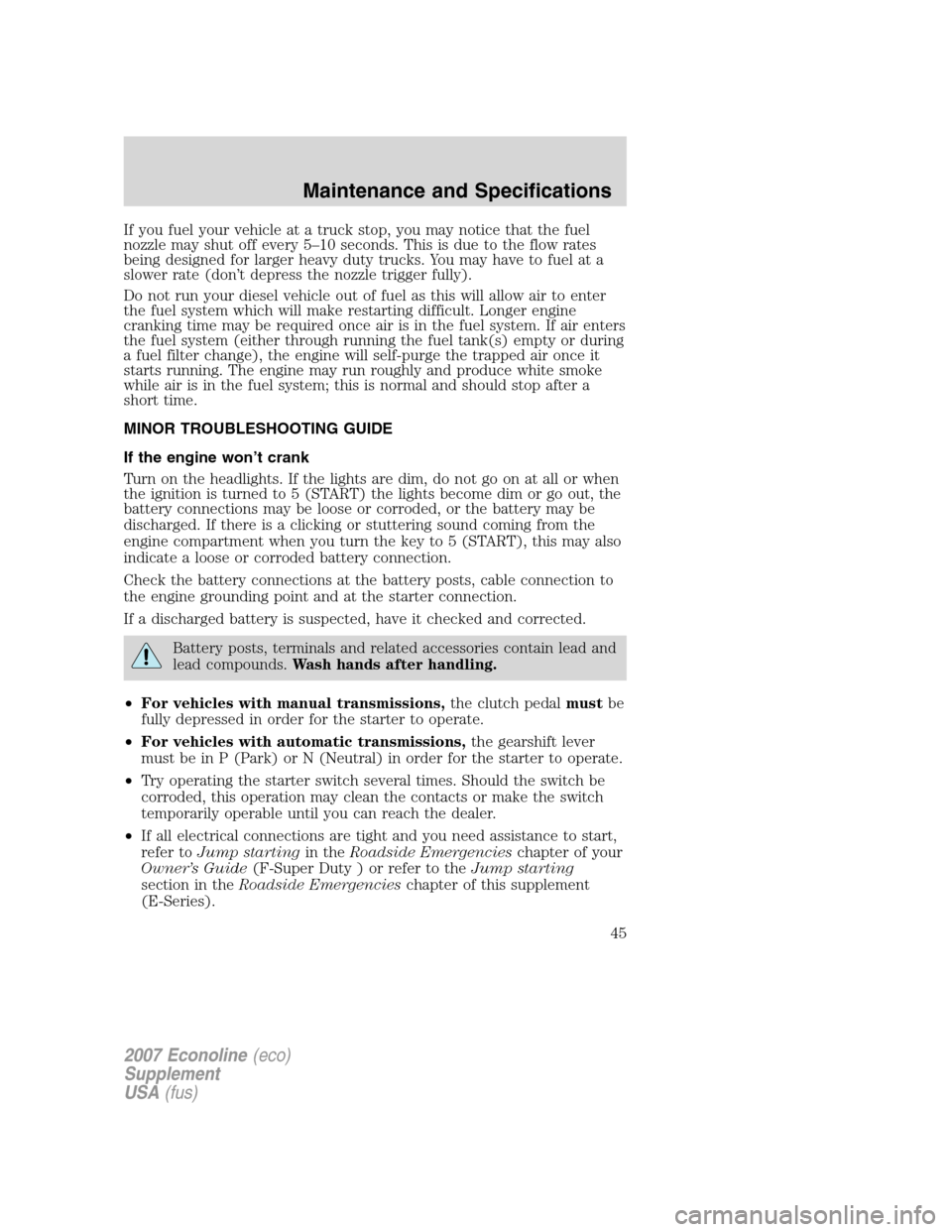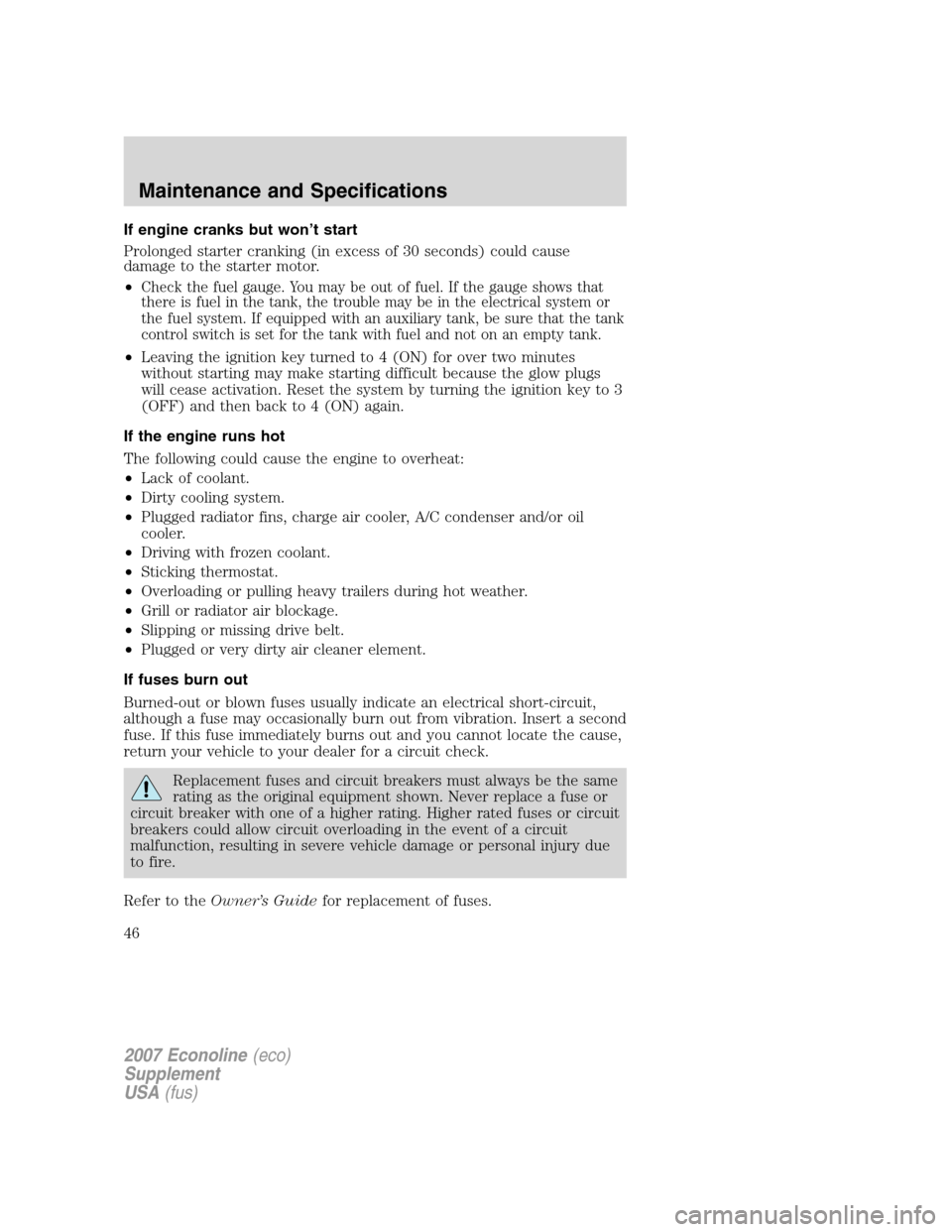Page 41 of 72
3. Disconnect the mass air flow
(MAF) sensor electrical connector.
(Slide out the red lock, press tab
and remove the electrical
connector.)
4. Disconnect the three latches and
remove the air cleaner cover
5. Remove the air cleaner element.
6. To install, reverse the removal procedure.
•F-Super Duty air filter element:
1. Release and flip the toggle clamps
back.
2007 Econoline(eco)
Supplement
USA(fus)
Maintenance and Specifications
41
Page 42 of 72
2. Remove the rear cover (the cover
near the coolant reservoir) from the
filter element by pushing it back
and pulling up to disengage the tabs
on the cover from the slots on the
filter element.
Rear cover tabs must be
disengaged from the slots before
pushing it or damage to the air
cleaner element will occur.
3. Push the cover to the rear under
the coolant reservoir and behind the
slots on the filter element.
4. Remove the front cover from the
filter element by pulling the cover
forward and pulling up to disengage
the tabs on the cover from the slots
on the filter element while pulling
up on the rear of the filter element.
Front cover tabs must be
disengaged from the slots before
pulling it or damage to the air
cleaner element will occur.
2007 Econoline(eco)
Supplement
USA(fus)
Maintenance and Specifications
42
Page 43 of 72

5. Pull up on the filter element to
remove it.
6. Installation is reverse of removal.
When servicing the air filter, always be sure that the auxiliary
hose is not kinked or obstructed and that it is placed back into
the hole in the front cowl near the back of the headlamp. Check
all hose and wiring positions. Failure to do so may result in
severe engine damage when driving through deep water and/or
encountering unusually heavy precipitation conditions.
EMISSION CONTROL SYSTEM(S) LAWS
Federal law prohibits vehicle manufacturers, dealers and other persons
engaged in the business of repairing, servicing, selling, leasing or trading
motor vehicles as well as fleet operations from unknowingly removing or
rendering emission control system(s) inoperative. Further, modifications
of the emission control system(s) could create liability on the part of the
individual owners under the laws of some states. In Canada,
modifications of the emission control system(s) could create liability
under applicable Federal or Provincial laws.
Do not remove or alter the original equipment floor covering or
insulation between it and the metal floor of the vehicle. The floor
covering and insulation protect occupants of the vehicle from the engine
and exhaust system heat and noise. On vehicles with no original
equipment floor covering insulation, do not carry passengers in a manner
that permits prolonged skin contact with the metal floor. Provide
adequate insulation.
NOISE EMISSIONS WARRANTY, PROHIBITED TAMPERING ACTS
AND MAINTENANCE
On January 1, 1978, Federal regulation became effective governing the
noise emission on trucks over 10,000 lbs. (4,536 kg) GVWR (Gross
Vehicle Weight Rating). The following statements concerning prohibited
tampering acts and maintenance, and the noise warranty found in the
Warranty Guide, are applicable to complete chassis cabs over 10,000
lbs. (4,536 kg) GVWR.
2007 Econoline(eco)
Supplement
USA(fus)
Maintenance and Specifications
43
Page 44 of 72

Tampering with noise control system prohibited
Federal law prohibits the following acts or the causing thereof: (1) The
removal or rendering inoperative by any person other than for purposes
of maintenance, repair or replacement of any device or element of design
incorporated into any new vehicle for the purpose of noise control prior
to its sale or delivery to the ultimate purchaser or while it is in use, or
(2) the use of the vehicle after such device or element of design has
been removed or rendered inoperative by any person.
Among those acts which the U.S. Environmental Protection Agency may
presume to constitute tampering are the acts listed below:
•Removal of hood blanket, fender apron absorbers, fender apron
barriers, underbody noise shields or acoustically absorptive material.
•Tampering or rendering inoperative the engine speed governor, so as
to allow engine speed to exceed manufacturer’s specifications.
The complexity of the diesel engine makes it so the owner is discouraged
from attempting to perform maintenance other than the services
described in this supplement.
If you experience difficult starting, rough idling, excessive exhaust
smoke, a decrease in engine performance or excess fuel consumption,
perform the following checks:
•a plugged air inlet system or engine air filter element.
•water in the fuel filter/water separator.
•a clogged fuel filter.
•contaminated fuel.
•air in the fuel system, due to loose connections.
•an open or pinched sensor hose.
•low engine oil level.
•wrong fuel or oil viscosity for climactic conditions.
If these checks do not help you correct the engine performance problem
you are experiencing, consult an authorized dealer.
FUELING
Do not use starting fluid such as ether or gasoline in the diesel
air intake system. Such fluids can cause immediate explosive
damage to the engine and possible personal injury.
2007 Econoline(eco)
Supplement
USA(fus)
Maintenance and Specifications
44
Page 45 of 72

If you fuel your vehicle at a truck stop, you may notice that the fuel
nozzle may shut off every 5–10 seconds. This is due to the flow rates
being designed for larger heavy duty trucks. You may have to fuel at a
slower rate (don’t depress the nozzle trigger fully).
Do not run your diesel vehicle out of fuel as this will allow air to enter
the fuel system which will make restarting difficult. Longer engine
cranking time may be required once air is in the fuel system. If air enters
the fuel system (either through running the fuel tank(s) empty or during
a fuel filter change), the engine will self-purge the trapped air once it
starts running. The engine may run roughly and produce white smoke
while air is in the fuel system; this is normal and should stop after a
short time.
MINOR TROUBLESHOOTING GUIDE
If the engine won’t crank
Turn on the headlights. If the lights are dim, do not go on at all or when
the ignition is turned to 5 (START) the lights become dim or go out, the
battery connections may be loose or corroded, or the battery may be
discharged. If there is a clicking or stuttering sound coming from the
engine compartment when you turn the key to 5 (START), this may also
indicate a loose or corroded battery connection.
Check the battery connections at the battery posts, cable connection to
the engine grounding point and at the starter connection.
If a discharged battery is suspected, have it checked and corrected.
Battery posts, terminals and related accessories contain lead and
lead compounds.Wash hands after handling.
•For vehicles with manual transmissions,the clutch pedalmustbe
fully depressed in order for the starter to operate.
•For vehicles with automatic transmissions,the gearshift lever
must be in P (Park) or N (Neutral) in order for the starter to operate.
•Try operating the starter switch several times. Should the switch be
corroded, this operation may clean the contacts or make the switch
temporarily operable until you can reach the dealer.
•If all electrical connections are tight and you need assistance to start,
refer toJump startingin theRoadside Emergencieschapter of your
Owner’s Guide(F-Super Duty ) or refer to theJump starting
section in theRoadside Emergencieschapter of this supplement
(E-Series).
2007 Econoline(eco)
Supplement
USA(fus)
Maintenance and Specifications
45
Page 46 of 72

If engine cranks but won’t start
Prolonged starter cranking (in excess of 30 seconds) could cause
damage to the starter motor.
•
Check the fuel gauge. You may be out of fuel. If the gauge shows that
there is fuel in the tank, the trouble may be in the electrical system or
the fuel system. If equipped with an auxiliary tank, be sure that the tank
control switch is set for the tank with fuel and not on an empty tank.
•Leaving the ignition key turned to 4 (ON) for over two minutes
without starting may make starting difficult because the glow plugs
will cease activation. Reset the system by turning the ignition key to 3
(OFF) and then back to 4 (ON) again.
If the engine runs hot
The following could cause the engine to overheat:
•Lack of coolant.
•Dirty cooling system.
•Plugged radiator fins, charge air cooler, A/C condenser and/or oil
cooler.
•Driving with frozen coolant.
•Sticking thermostat.
•Overloading or pulling heavy trailers during hot weather.
•Grill or radiator air blockage.
•Slipping or missing drive belt.
•Plugged or very dirty air cleaner element.
If fuses burn out
Burned-out or blown fuses usually indicate an electrical short-circuit,
although a fuse may occasionally burn out from vibration. Insert a second
fuse. If this fuse immediately burns out and you cannot locate the cause,
return your vehicle to your dealer for a circuit check.
Replacement fuses and circuit breakers must always be the same
rating as the original equipment shown. Never replace a fuse or
circuit breaker with one of a higher rating. Higher rated fuses or circuit
breakers could allow circuit overloading in the event of a circuit
malfunction, resulting in severe vehicle damage or personal injury due
to fire.
Refer to theOwner’s Guidefor replacement of fuses.
2007 Econoline(eco)
Supplement
USA(fus)
Maintenance and Specifications
46
Page 47 of 72
MOTORCRAFT PART NUMBERS
Item Ford Part Number
Engine oil filter FL-2016
Air Filter – Super Duty
14C3Z-9601-AA
Air Filter – E-series1FA-1804
Fuel filter (2 required) FD-4604
Battery (2 Required) BXT-65-750
1Always use the authorized Motorcraft air filter listed.Failure to use
the correct air filter may result in severe engine damage.
REFILL CAPACITIES
Component Capacity
Cooling system127.5 quarts (26.0L)
Engine oil215.0 quarts (14.2L)
Fuel tankRefer to yourOwner’s
Guide
Radiator cap 16 psi (110 kPa)
Manual transmission
35.8 quarts (5.5L)
Automatic transmissionRefer to yourOwner’s
Guide
1Includes heater and 5.0 quarts (4.7L) in coolant recovery.
2Includes 1 quart (1.0L) in engine oil filter.
3Use Motorcraft MERCON�ATF, Motorcraft part number XT-2–QDX,
meeting Ford specification MERCON�.
2007 Econoline(eco)
Supplement
USA(fus)
Maintenance and Specifications
47
Page 48 of 72
LUBRICANT SPECIFICATIONS
ItemFord Part
NameFord Part
NumberFord
Specification
Engine OilMotorcraft
Motor Oil 15W40
Super Duty,
10W30 Super
Duty
1
XO-15W40-QSD,
XO-10W30-QSDWSS-M2C171-D
Engine coolant Motorcraft
Premium Gold
Engine Coolant
(yellow-colored)VC-7-B WSS-M97B51–A1
Manual
TransmissionMotorcraft
MERCON�AT FXT-2–QDX MERCON�
Automatic
transmissionRefer to Owner’s Guide
1Refer to the engine oil specification chart located underEngine oil
specificationsin this chapter.
2007 Econoline(eco)
Supplement
USA(fus)
Maintenance and Specifications
48